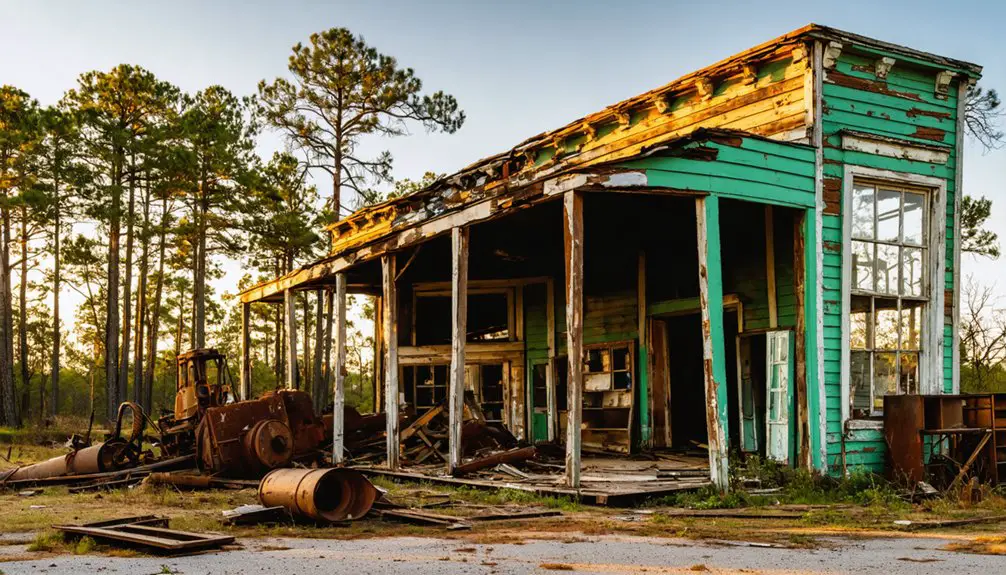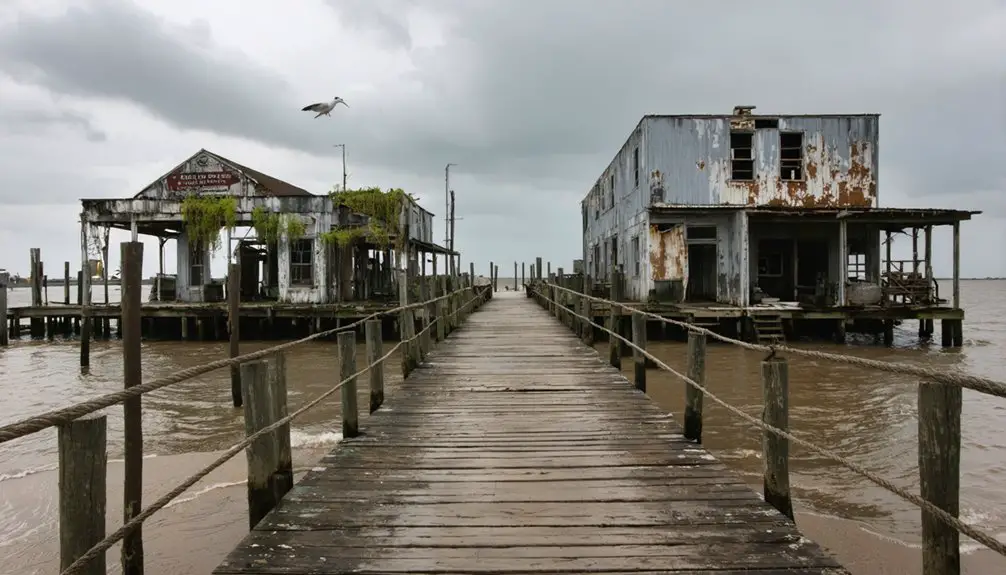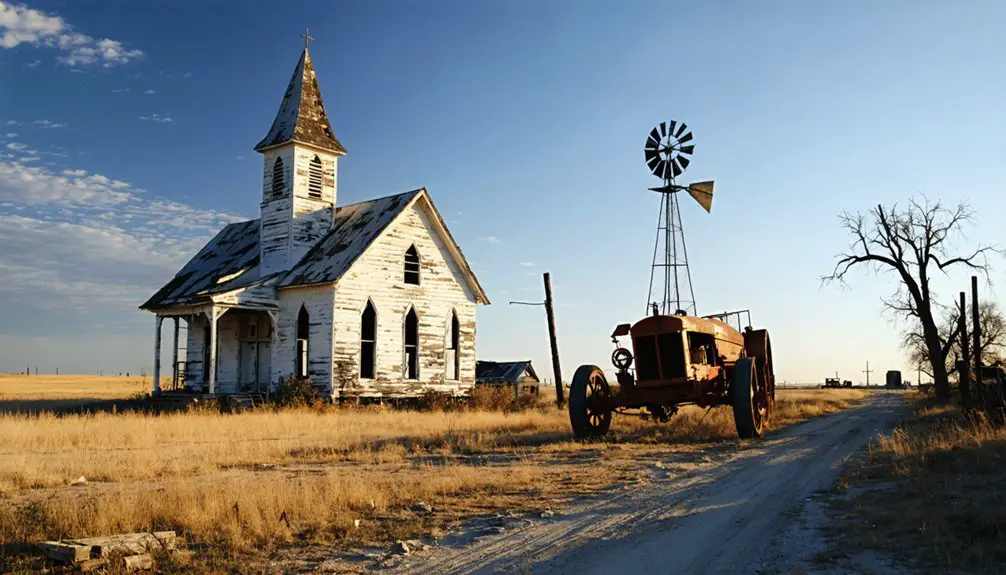You’ll find Belzora’s ghost town remnants along the Sabine River between Tyler and Longview, where a thriving 1850s river port once stood. The town’s strategic location made it East Texas’s prime cotton trading hub, boasting a dozen businesses, post office, and church-schoolhouse. When railroads arrived in the 1870s, they diverted commerce from river routes, leading to Belzora’s abandonment. The site’s hidden stories reveal how transportation shaped Texas frontier settlements.
Key Takeaways
- Belzora flourished as a major East Texas trade hub in the 1850s due to its strategic location on the Sabine River.
- The town featured twelve businesses, a post office, and church-schoolhouse during its peak period of commercial activity.
- River-based commerce drove Belzora’s economy, with cotton trade and steamboat operations serving as primary economic activities.
- The arrival of railroads in the 1870s diverted trade routes, causing Belzora’s rapid economic decline and population loss.
- Belzora transitioned from bustling river port to ghost town when rail transportation replaced river trade in East Texas.
Early Settlement Along the Sabine River
While indigenous peoples had inhabited the Sabine River basin for millennia, Anglo-American settlement began in earnest during the late 1820s as pioneers pushed westward from the Trinity and Neches River regions.
You’ll find evidence of rich Caddo culture dating back to A.D. 780, marked by impressive mound-building activities that represented the region’s peak indigenous development.
The early settlers who ventured into this territory included families like the Tevis, Lewis, Hillebrandt, and McFaddin clans. They established themselves between 1825 and 1833, focusing on cotton cultivation and cattle ranching. The abundant annual rainfall in the region helped sustain their agricultural endeavors.
These pioneers laid claim to strategic locations along the Sabine, including Tevis Bluff in 1834. Under the Municipality of Atascocita, later renamed Liberty, they created self-governing communities that would shape the region’s future development. The area’s cotton industry flourished rapidly, with exports growing from 84 bales in 1838 to over 15,000 bales by 1858.
The Rise of a Bustling River Port
You’ll find Belzora’s strategic placement at the head of Sabine River navigation, some 250 miles inland, made it an ideal location for East Texas commerce in the 1850s.
The port’s position between Tyler and Longview helped it capture the region’s lucrative cotton trade, while Patton’s Ferry served travelers on the crucial Dallas-to-Shreveport post road. Uncle Ben steamboat made regular trips between 1853-1856, efficiently transporting cotton cargo through the port.
During high-water periods, steamboats like the Buffalo would dock at Belzora’s landing, transforming this riverside settlement into a bustling commercial hub with a dozen thriving businesses, including a post office and church-schoolhouse. The settlement’s fortunes declined when lack of improvements to inland navigation made the port increasingly difficult to access.
Strategic River Location Advantages
The strategic location of Belzora at the head of navigation on the Sabine River transformed this Texas settlement into an essential inland port during the mid-1800s.
You’d find its position uniquely advantageous, as abundant rainfall and favorable terrain kept the river navigable for extended periods throughout the year. During heavy rains from 1845-1865, torrential flooding greatly aided river navigation.
The settlement’s natural river route connected you directly to major trade hubs like Tyler, Dallas, and Shreveport, while its position on the Dallas-to-Shreveport Post Road integrated both water and land transportation. Tyler’s emergence as an important investment and banking center helped fuel Belzora’s commercial growth through increased river trade.
Despite river navigation challenges, Belzora’s merchants mastered the art of timing their shipments with seasonal floods. They’d load goods onto barges during dry spells, then capitalize on sudden freshets to move cargo downstream efficiently – a strategy that turned transportation challenges into profitable opportunities.
Early Trade Hub Development
Building upon its strategic river location, Belzora flourished into a dynamic trade center during the 1850s, where cotton reigned supreme as the primary commodity.
You’d find merchants orchestrating an extensive cotton trade with Mexico, exchanging the valuable crop for essential military supplies, medicine, and clothing.
The town’s dozen businesses, post office, and crucial ferry service supported a thriving agricultural exchange network. Radford Berry’s ferries transported countless travelers and goods across the waters.
Local farmers supplied corn, cured meats, and livestock while state and private industries manufactured critical goods like guns, ammunition, and leather products.
The Sabine River’s navigability enabled smooth transport of goods between major economic hubs in the region.
Shallow-draft steamboats, barges, and flatboats navigated the Sabine’s seasonal waters, while wagon trains provided reliable overland transport.
This versatile transportation system transformed Belzora into a bustling inland port that connected East Texas with broader markets.
Steamboat Commerce Flourishes
During peak seasons when water levels permitted, light steamboats churned up the Trinity River to Belzora’s busy landing, where you’d find up to fifteen vessels operating along the waterway by 1871.
These essential steamboat routes connected you to Galveston and other Texas ports, while the town’s strategic location on the Dallas-to-Shreveport post road made it a significant transportation hub.
You’d see a variety of cargo moving through Belzora’s port – cotton bales destined for distant markets, nursery stock including locally grown rosebushes, mail, and general merchandise.
When water levels dropped during dry spells, merchants would load their goods onto barges and flatboats, patiently awaiting the next freshet to continue downstream.
The steady rhythm of commerce and the distinctive steamboat whistles defined Belzora’s golden age as a river port. Navigating the thousand-mile waterway from Hunt County to the Gulf of Mexico posed significant challenges for vessel operators.
By 1900, many vessels like the Uncle Ben gunboat had transported significant amounts of cotton through the region’s vital river trade network.
Daily Life in Belzora’s Heyday
If you’d visited Belzora during its prime, you’d have found residents bustling between the dozen local businesses and post office, conducting their daily trade as steamboats and barges moved goods along the Sabine River.
At the heart of community life stood the combination church-schoolhouse, where townspeople gathered for worship, education, and social events throughout the week.
The port’s daily rhythm depended heavily on seasonal river conditions, with merchants and traders adapting their routines to store goods during dry spells and accelerate shipments when water levels permitted navigation.
River Trade Daily Routine
Life along Belzora’s riverfront pulsed with the daily rhythm of commerce and trade, as merchants and workers coordinated the loading and unloading of vessels at the town’s bustling boat landing.
You’d find steamboats bringing mail, merchandise, and passengers, while flatboats and barges waited for higher water to carry their cargo downstream.
During peak seasons, you could watch thousands of cotton bales moving through the port, with commission firms carefully recording each shipment in their ledgers.
When river levels dropped, you’d see crews stockpiling goods in nearby warehouses until the next freshet allowed safe passage.
The arrival of steamboats transformed daily routines, drawing townspeople to the landing to collect mail, purchase new goods, and gather news from distant ports.
Community Gathering Spots
At the heart of Belzora’s social fabric stood a combination church-schoolhouse, where you’d find townspeople gathering daily for both spiritual and educational purposes.
This multifunctional building served as the cornerstone for community events and social gatherings that strengthened local bonds.
You’d encounter neighbors at the bustling post office, where more than just mail was exchanged – news, stories, and local happenings filled the air.
The ferry landing and post road crossing created natural meeting spots where travelers and locals alike would converge.
While conducting business at one of the dozen local establishments, you’d join in conversations and catch up with fellow residents.
Even without dedicated recreational spaces, Belzora’s residents found ways to connect through informal gatherings, seasonal celebrations, and communal work activities.
Local Business Operations
During Belzora’s peak years, you’d find the town bustling with roughly a dozen mercantile businesses centered around its crucial river port operations.
Local merchants faced constant trade fluctuations tied to the Sabine River’s seasonal navigability. You could spot steamboats loading and unloading goods during wet seasons, while barges and flatboats waited out drier periods for sudden floods to move downstream.
The town’s commercial heart revolved around its boat landing, where general stores supplied settlers with essential goods transported via river. Merchants’ challenges included coordinating with agricultural cycles and adapting to river conditions.
The post office served as a crucial hub for communication and commerce, though business prospects eventually dimmed when railroads diverted traffic in the 1870s, leading to the town’s decline.
Transportation Hub and Trade Routes
Strategically positioned along the Sabine River, Belzora emerged as an essential transportation nexus in 1850s East Texas, connecting river commerce with overland trade routes.
You’d find steamboats steering the winding Sabine during wet seasons, while barges and flatboats handled cargo during drier periods. The town’s ferry operations served travelers along the Dallas-to-Shreveport Post Road, creating important links between Texas and Louisiana markets.
Through Belzora’s port, you could ship cotton, corn, leather goods, and military supplies to distant markets in Mexico and Southern states.
Bustling Belzora served as a vital gateway, moving everything from cotton to military supplies across the American South and into Mexico.
The town’s dual role as both river port and overland crossing point made it indispensable to regional commerce until the 1870s, when railroad expansion shifted trade patterns and ultimately led to Belzora’s decline.
Economic Impact on East Texas

The economic foundations of Belzora mirrored a common pattern across East Texas ghost towns – heavy dependence on natural resources that proved unsustainable.
You’ll find that Belzora’s reliance on river trade and agriculture made it particularly vulnerable when economic shifts occurred. The lack of economic diversification left the town exposed to devastating boom-bust cycles.
As agricultural mechanization reduced labor demands and soil quality deteriorated, you could see the town’s population decline accelerate.
The impact wasn’t isolated – Belzora’s struggles reflected broader regional challenges. When critical infrastructure changes disrupted traditional trade routes and the oil industry faced downturns, local economies couldn’t adapt.
The town’s fate serves as a stark reminder of how natural resource dependency and limited economic alternatives can transform thriving communities into abandoned settlements.
The Arrival of the Railroad Era
When railroads surged through East Texas in the 1870s, you’d find Belzora’s destiny permanently altered. The railroad expansion brought year-round reliability that the seasonal Sabine River couldn’t match, making the town’s river port increasingly obsolete.
The railroad’s arrival marked the end for Belzora, as steel rails outpaced the Sabine’s seasonal flow in reliability and speed.
You’ll understand the transportation revolution‘s impact when you consider how quickly commerce shifted. While Belzora’s residents once relied on slow-moving steamboats and flatboats, the railways now connected regional centers with unprecedented speed and efficiency.
The post-Civil War push to establish inland trade routes sealed Belzora’s fate. Businesses and populations migrated to rail-connected towns like Tyler, abandoning the old river routes.
The railroad’s arrival didn’t just change how goods moved – it transformed the entire economic landscape of East Texas, leaving river towns like Belzora behind.
From Thriving Port to Abandoned Town

Situated advantageously on the Sabine River, Belzora emerged in the 1850s as a bustling inland port that you’d scarcely recognize today.
The town’s dozen businesses, post office, and church-schoolhouse once served as essential lifelines for East Texas commerce and travel.
Yet the challenges of river navigation proved insurmountable. You’d have found steamboats struggling with the Sabine’s winding course, while seasonal water levels forced merchants to stockpile goods until flooding could carry them downstream.
As railroads carved new transportation corridors across Texas in the 1870s, Belzora’s economic decline became inevitable. The reliable year-round service of trains quickly overshadowed river commerce, and residents abandoned their once-promising port.
Today, only scattered tombstones and a historical marker remain to tell Belzora’s story of boom and bust.
Historical Significance and Legacy
Despite its short-lived prominence, Belzora’s historical significance extends far beyond its physical remains. You’ll find its legacy woven into the cultural heritage of East Texas, where it served as a crucial link in the region’s 19th-century transportation network.
The town’s strategic location along the ancient Vial-Fragoso Trail and its role as a bustling Sabine River port helped shape early commerce between Texas and Louisiana.
Today, as a ghost town marked only by scattered tombstones and historical marker #7705, Belzora stands as a tribute to how technological progress can reshape communities.
While railroads may have sealed its fate, you can still trace its influence in the development patterns of East Texas, where river-based settlements laid the groundwork for modern transportation corridors.
Frequently Asked Questions
Are There Any Known Photographs or Sketches of Belzora From Its Peak?
Despite Belzora’s historical significance as a river port, you won’t find any confirmed photographs or sketches from its peak period. The limited visual documentation reflects its brief prominence before widespread photography.
What Native American Tribes Originally Inhabited the Area Around Belzora?
Where the wind once whispered through ancient settlements, you’ll find the Anadarko (Nondacao) tribe’s cultural significance shaped this land until 1788, followed by Cherokee settlers who established historical trade routes until 1839.
Did Any Notable Historical Figures Visit or Stay in Belzora?
You won’t find records of notable visitors or historically significant figures staying in Belzora. While the port town served river trade and travelers, no documented evidence exists of prominent personalities visiting there.
What Happened to the Residents After Belzora Was Abandoned?
You’ll find their relocation stories aren’t glamorous – they scattered to Tyler and nearby towns, trading their river-based lives for railroad jobs and farming, while their once-tight community gradually dissolved into neighboring settlements.
Are There Any Preserved Artifacts From Belzora in Local Museums?
You’ll find limited artifacts at the Smith County Historical Society, though they’re mainly archival materials like documents and letters. There aren’t significant local exhibitions specifically showcasing Belzora’s material remains.
References
- https://www.etgsaux.online/txsmith/histmark/smithco.shtml
- https://discovertexasoutdoors.com/places/belzora/
- https://texashighways.com/travel-news/four-texas-ghost-towns/
- https://www.hipcamp.com/journal/camping/texas-ghost-towns/
- https://www.tshaonline.org/handbook/entries/belzora-tx
- https://en.wikipedia.org/wiki/List_of_ghost_towns_in_Texas
- https://atlas.thc.texas.gov/Details/5423007705/print
- https://www.ghosttowns.com/states/tx/belzora.html
- https://www.youtube.com/watch?v=T7hj1iweWi8
- http://www.wtblock.com/civilwar1.htm



